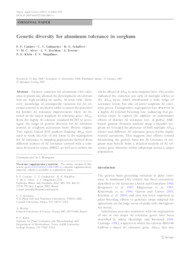Genetic diversity for aluminum tolerance in sorghum.
Genetic diversity for aluminum tolerance in sorghum.
Autoria: CANIATO, F. F.; GUIMARAES, C. T.; SCHAFFERT, R. E.; ALVES, V. M. C.; KOCHIAN, L. V.; BOREM, A.; KLEIN, P. E.; MAGALHAES, J. V.
Resumo: Genetic variation for aluminum (Al) tolerance in plants has allowed the development of cultivars that are high yielding on acidic, Al toxic soils. However, knowledge of intraspecific variation for Al tolerance control is needed in order to assess the potential for further Al tolerance improvement. Here we focused on the major sorghum Al tolerance gene, Alt SB , from the highly Al tolerant standard SC283 to investigate the range of genetic diversity for Al tolerance control in sorghum accessions from diverse origins. Two tightly linked STS markers flanking Alt SB were used to study the role of this locus in the segregation for Al tolerance in mapping populations derived from different sources of Al tolerance crossed with a common Al sensitive tester, BR012, as well as to isolate the allelic effects of Alt SB in near-isogenic lines. The results indicated the existence not only of multiple alleles at the Alt SB locus, which conditioned a wide range of tolerance levels, but also of novel sorghum Al tolerance genes. Transgressive segregation was observed in a highly Al tolerant breeding line, indicating that potential exists to exploit the additive or codominant effects of distinct Al tolerance loci. A global, SSR-based, genetic diversity analysis using a broader sorghum set revealed the presence of both multiple Alt SB alleles and different Al tolerance genes within highly related accessions. This suggests that efforts toward broadening the genetic basis for Al tolerance in sorghum may benefit from a detailed analysis of Al tolerance gene diversity within subgroups across a target population.
Ano de publicação: 2007
Tipo de publicação: Artigo de periódico
Unidade: Embrapa Milho e Sorgo
Palavras-chave: Sorgo, Variação Genética
Observações
1 - Por padrão são exibidas publicações dos últimos 20 anos. Para encontrar publicações mais antigas, configure o filtro ano de publicação, colocando o ano a partir do qual você deseja encontrar publicações. O filtro está na coluna da esquerda na busca acima.
2 - Para ler algumas publicações da Embrapa (apenas as que estão em formato ePub), é necessário ter, no celular ou computador, um desses softwares gratuitos. Sistemas Android: Google Play Livros; IOS: iBooks; Windows e Linux: software Calibre.
Acesse outras publicações
Acesse a Base de Dados da Pesquisa Agropecuária (BDPA) para consultar o acervo completo das bibliotecas da Embrapa.

